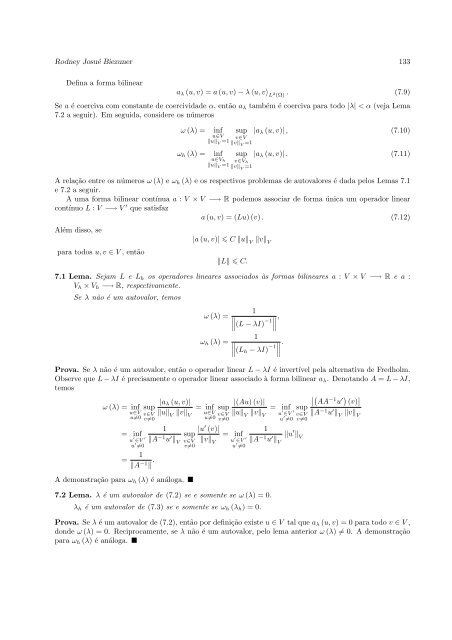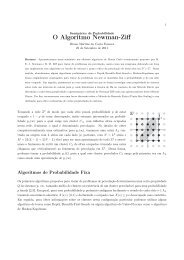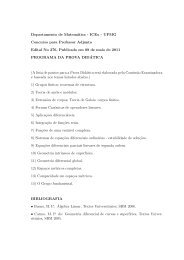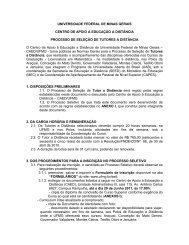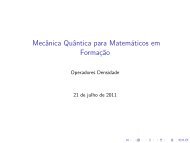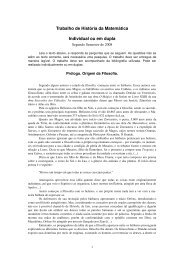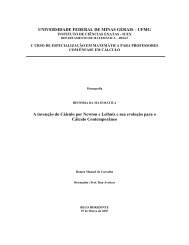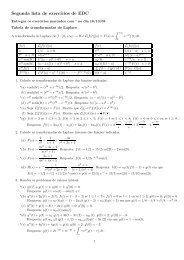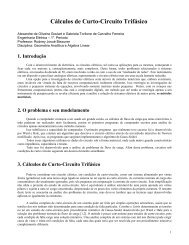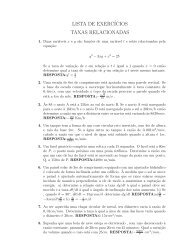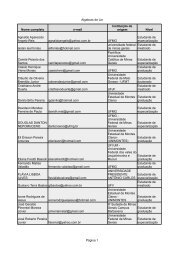Autovalores do Laplaciano - Departamento de Matemática - UFMG
Autovalores do Laplaciano - Departamento de Matemática - UFMG
Autovalores do Laplaciano - Departamento de Matemática - UFMG
Create successful ePaper yourself
Turn your PDF publications into a flip-book with our unique Google optimized e-Paper software.
Rodney Josué Biezuner 133<br />
Defina a forma bilinear<br />
aλ (u, v) = a (u, v) − λ 〈u, v〉 L 2 (Ω) . (7.9)<br />
Se a é coerciva com constante <strong>de</strong> coercivida<strong>de</strong> α, então aλ também é coerciva para to<strong>do</strong> |λ| < α (veja Lema<br />
7.2 a seguir). Em seguida, consi<strong>de</strong>re os números<br />
ω (λ) = inf<br />
u∈V<br />
sup<br />
v∈V<br />
uV =1 vV =1<br />
ωh (λ) = inf<br />
u∈Vh<br />
uV =1<br />
sup<br />
v∈Vh<br />
v V =1<br />
|aλ (u, v)| , (7.10)<br />
|aλ (u, v)| . (7.11)<br />
A relação entre os números ω (λ) e ωh (λ) e os respectivos problemas <strong>de</strong> autovalores é dada pelos Lemas 7.1<br />
e 7.2 a seguir.<br />
A uma forma bilinear contínua a : V × V −→ R po<strong>de</strong>mos associar <strong>de</strong> forma única um opera<strong>do</strong>r linear<br />
contínuo L : V −→ V ′ que satisfaz<br />
a (u, v) = (Lu) (v) . (7.12)<br />
Além disso, se<br />
para to<strong>do</strong>s u, v ∈ V , então<br />
|a (u, v)| C u V v V<br />
L C.<br />
7.1 Lema. Sejam L e Lh os opera<strong>do</strong>res lineares associa<strong>do</strong>s às formas bilineares a : V × V −→ R e a :<br />
Vh × Vh −→ R, respectivamente.<br />
Se λ não é um autovalor, temos<br />
1<br />
ω (λ) = <br />
<br />
(L − λI) −1 ,<br />
<br />
1<br />
ωh (λ) = <br />
<br />
(Lh − λI) −1 .<br />
<br />
Prova. Se λ não é um autovalor, então o opera<strong>do</strong>r linear L − λI é invertível pela alternativa <strong>de</strong> Fredholm.<br />
Observe que L − λI é precisamente o opera<strong>do</strong>r linear associa<strong>do</strong> à forma bilinear aλ. Denotan<strong>do</strong> A = L − λI,<br />
temos<br />
ω (λ) = inf sup<br />
u∈V v∈V<br />
u=0 v=0<br />
= inf<br />
u ′ ∈V ′<br />
u ′ =0<br />
=<br />
1<br />
A −1 .<br />
|aλ (u, v)|<br />
u V v V<br />
1<br />
A −1 u ′ V<br />
A <strong>de</strong>monstração para ωh (λ) é análoga. <br />
= inf sup<br />
u∈V v∈V<br />
u=0 v=0<br />
|u<br />
sup<br />
v∈V<br />
v=0<br />
′ (v)|<br />
= inf<br />
vV u ′ ∈V ′<br />
u ′ =0<br />
|(Au) (v)|<br />
u V v V<br />
1<br />
= inf<br />
A −1 u ′ V<br />
7.2 Lema. λ é um autovalor <strong>de</strong> (7.2) se e somente se ω (λ) = 0.<br />
λh é um autovalor <strong>de</strong> (7.3) se e somente se ωh (λh) = 0.<br />
u ′ ∈V ′<br />
u ′ =0<br />
sup<br />
v∈V<br />
v=0<br />
u ′ V<br />
<br />
AA −1 u ′ (v) <br />
A −1 u ′ V v V<br />
Prova. Se λ é um autovalor <strong>de</strong> (7.2), então por <strong>de</strong>finição existe u ∈ V tal que aλ (u, v) = 0 para to<strong>do</strong> v ∈ V ,<br />
<strong>do</strong>n<strong>de</strong> ω (λ) = 0. Reciprocamente, se λ não é um autovalor, pelo lema anterior ω (λ) = 0. A <strong>de</strong>monstração<br />
para ωh (λ) é análoga.


